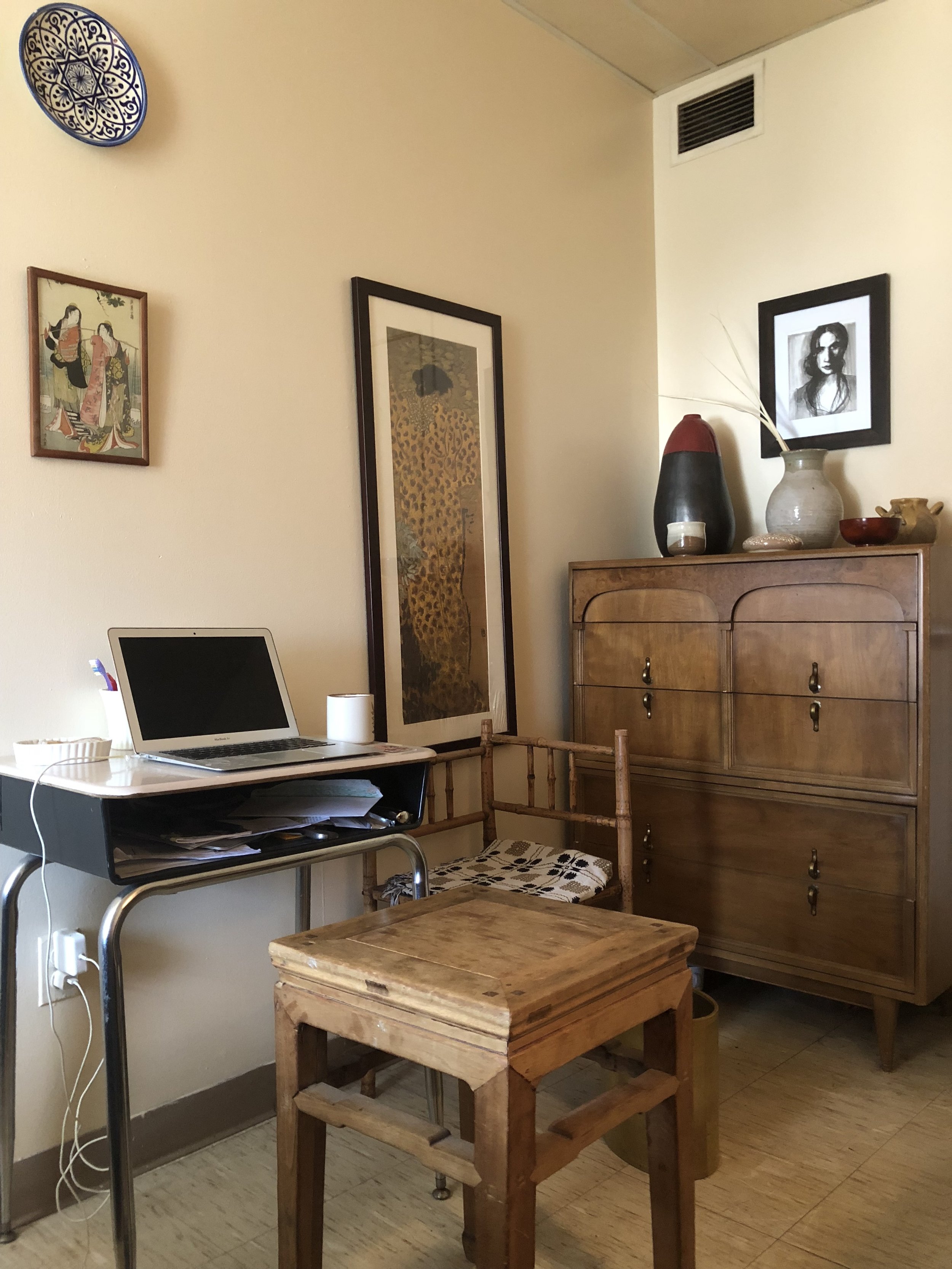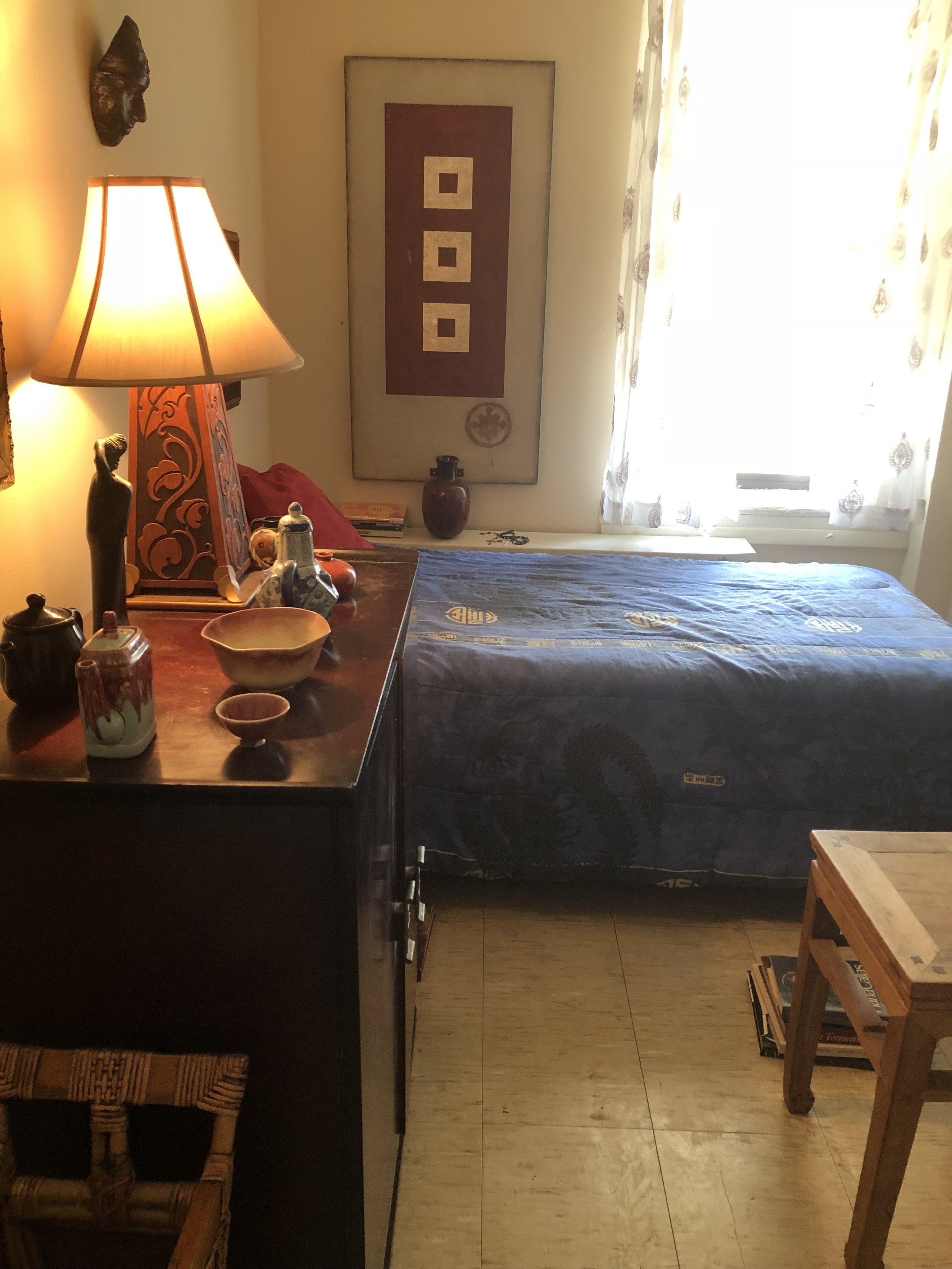NO IDEAS BUT IN THINGS
Lisa Zeiger
A painting by Andrew Lord, 2014, that served as the central talisman of my room. Its red and blue are echoed throughout the other objects.
“Things men have made with wakened
hands, and put soft life into
are awake through years with transferred touch,
and go on glowing for long years.
And for this reason,
some old things are lovely warm
still with the life of forgotten men who
made them.”
—D.H. Lawrence
No matter how we banish clutter, the human need to collect resurfaces. Edith Wharton Wharton and Ogden Codman Jr., at the end of their 1897 manifesto, The Decoration of Houses, acknowledged this stubborn atavism in a chapter entitled “Bric-a-Brac”. The authors exhort us to control such residue by distinguishing three levels of quality among “household ornaments”: bric-a-brac, bibelots (trinkets) and objets d’art. If we include such unnecessaries in a room, they must attain Wharton’s “counsel of perfection.” An ugly chair may be excused but an ugly knick-knack must go. Bric-a-brac demands the taste of angels; “Tanagra figurine, never china pug.”
My own recipe for the ideal room is the opposite of Wharton’s. Long before I created totalized interiors, rethinking walls and windows, moldings and hearth, I unconsciously organized rooms around one or two small, cherished objects, talismans of my own taste. The display of such objects was in the spirit of a shrine: my bric-a-brac was the raison d’être for the entire room rather than the other way around.
An esoteric children’s book, Mr. Meredith and the Truly Remarkable Stone by Grace Chetwin, illustrates my point perfectly. When Mr. Meredith finds an old cracked stone which moves him as if by spectacular beauty, he builds a series of ever-grander structures to house it, beginning with a small pavilion, then a palace, and finally a city. With the success of each structure he entertains guests, simply at first; with greater extravagance as the structures expand. Eventually Mr. Meredith forgets all about the old stone, small nucleus of concentric monuments, until one day he trips over it.
I once constructed a studio apartment around a particularly prized possession, a rare oil painting from the early 1980s by the German artist Rosemarie Trockel. It was of a black vessel with two playing cards against a smoky grey background. Two spectral eyes floated above the vessel. Like Mr. Meredith I bought ever larger, more expensive things to echo the darkness of the painting: a cabinet by Gilbert Rohde, a slate-topped table, shelves of raw stained mahogany, silver teapots by Christopher Dresser; an ebonized chair by Tiffany. Eventually, not quite forgetting the origin of the room but pinched for money, I sold the painting to finance a trip to an ashram in India. I was sacrificing material to heal my psyche, but I managed only to rob the room of its core. Still, the room, conceived and organized around the vanished painting remained beautiful, if missing its retablo.
Painting by Rosemarie Trockel, c. 1984. Photograph courtesy of Elise Boisante
Work is beautiful.
Wharton’s text reminds me of a deeper musing upon the relationship of minor elements to a grander totality, one written about literature rather than interior decoration. In the late 1970s I took a seminar at Columbia in French literature called “The Detail” from the late Professor Naomi Schor. In 1987 Schor, a highly original literary critic, would publish a book entitled Reading in Detail: Aesthetics and the Feminine. In it, Schor writes:
“My own love of the detail—and like all loves this love is shot through with ambivalence—is inextricably bound up with my Oedipus: my father, a goldsmith, was a master of ornamental detail, a Renaissance artist in the age of high modernism and minimalism [...] In asserting the detail’s claim to aesthetic dignity and epistemological prestige, my motivation is then double: to endow with legitimacy my own brand of feminist hermeneutics, while giving value to my father’s craft.”
Schor’s seminar—in which we read Balzac’s strange epic of an amulet, La peau de chagrin, and Freud’s essay “Fetishism”—brought intellectual heft to my obsession with small objects, with what Dickens’ character Wemmick, in Great Expectations, so charmingly calls “portable property”.
I would go on to a hybrid career of design historian and occasional interior decorator. I collected all sorts of things, some useful, some not. Books, teapots, ceramics, and Javanese furniture and sculpture. Yet I found coziness a shackle, and eventually ignited a chain of events leading to a bonfire of my own vanities, a forced potlatch of all my things, still lovely warm.
In a book by the homeopath and spiritual writer Edward Bach, I once read the following sentence: “Even objects have their freedom.” I have never been able to find it again, nor have I ever forgotten it.
La vie en rouge.
My two place settings of the Waldorf -Astoria silver-plate service.








